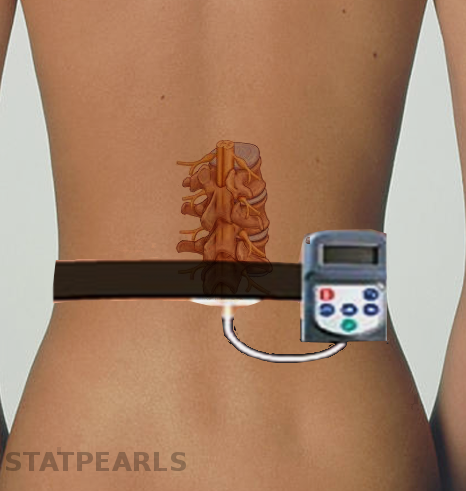[1]
Jain S, Malinowski M, Chopra P, Varshney V, Deer TR. Intrathecal drug delivery for pain management: recent advances and future developments. Expert opinion on drug delivery. 2019 Aug:16(8):815-822. doi: 10.1080/17425247.2019.1642870. Epub 2019 Jul 19
[PubMed PMID: 31305165]
Level 3 (low-level) evidence
[2]
Urman RD, Böing EA, Khangulov V, Fain R, Nathanson BH, Wan GJ, Lovelace B, Pham AT, Cirillo J. Analysis of predictors of opioid-free analgesia for management of acute post-surgical pain in the United States. Current medical research and opinion. 2019 Feb:35(2):283-289. doi: 10.1080/03007995.2018.1481376. Epub 2018 Jun 26
[PubMed PMID: 29799282]
Level 3 (low-level) evidence
[3]
Jain S, Deer T, Sayed D, Chopra P, Wahezi S, Jassal N, Weisbein J, Jameson J, Malinowski M, Golovac S. Minimally invasive lumbar decompression: a review of indications, techniques, efficacy and safety. Pain management. 2020 Sep:10(5):331-348. doi: 10.2217/pmt-2020-0037. Epub 2020 Jul 1
[PubMed PMID: 32609052]
[4]
Deer TR, Esposito MF, McRoberts WP, Grider JS, Sayed D, Verrills P, Lamer TJ, Hunter CW, Slavin KV, Shah JM, Hagedorn JM, Simopoulos T, Gonzalez DA, Amirdelfan K, Jain S, Yang A, Aiyer R, Antony A, Azeem N, Levy RM, Mekhail N. A Systematic Literature Review of Peripheral Nerve Stimulation Therapies for the Treatment of Pain. Pain medicine (Malden, Mass.). 2020 Aug 1:21(8):1590-1603. doi: 10.1093/pm/pnaa030. Epub
[PubMed PMID: 32803220]
Level 1 (high-level) evidence
[5]
Mobbs RJ, Nair S, Blum P. Peripheral nerve stimulation for the treatment of chronic pain. Journal of clinical neuroscience : official journal of the Neurosurgical Society of Australasia. 2007 Mar:14(3):216-21; discussion 222-3
[PubMed PMID: 17258129]
[6]
Nashold BS Jr, Goldner JL, Mullen JB, Bright DS. Long-term pain control by direct peripheral-nerve stimulation. The Journal of bone and joint surgery. American volume. 1982 Jan:64(1):1-10
[PubMed PMID: 6976348]
[7]
Deer TR, Jain S, Hunter C, Chakravarthy K. Neurostimulation for Intractable Chronic Pain. Brain sciences. 2019 Jan 24:9(2):. doi: 10.3390/brainsci9020023. Epub 2019 Jan 24
[PubMed PMID: 30682776]
[8]
Deer TR, Grider JS, Lamer TJ, Pope JE, Falowski S, Hunter CW, Provenzano DA, Slavin KV, Russo M, Carayannopoulos A, Shah JM, Harned ME, Hagedorn JM, Bolash RB, Arle JE, Kapural L, Amirdelfan K, Jain S, Liem L, Carlson JD, Malinowski MN, Bendel M, Yang A, Aiyer R, Valimahomed A, Antony A, Craig J, Fishman MA, Al-Kaisy AA, Christelis N, Rosenquist RW, Levy RM, Mekhail N. A Systematic Literature Review of Spine Neurostimulation Therapies for the Treatment of Pain. Pain medicine (Malden, Mass.). 2020 Nov 7:21(7):1421-1432. doi: 10.1093/pm/pnz353. Epub
[PubMed PMID: 32034422]
Level 1 (high-level) evidence
[9]
Huntoon MA, Huntoon EA, Obray JB, Lamer TJ. Feasibility of ultrasound-guided percutaneous placement of peripheral nerve stimulation electrodes in a cadaver model: part one, lower extremity. Regional anesthesia and pain medicine. 2008 Nov-Dec:33(6):551-7
[PubMed PMID: 19258970]
Level 2 (mid-level) evidence
[10]
Huntoon MA, Hoelzer BC, Burgher AH, Hurdle MF, Huntoon EA. Feasibility of ultrasound-guided percutaneous placement of peripheral nerve stimulation electrodes and anchoring during simulated movement: part two, upper extremity. Regional anesthesia and pain medicine. 2008 Nov-Dec:33(6):558-65
[PubMed PMID: 19258971]
Level 2 (mid-level) evidence
[11]
Ilfeld BM, Gilmore CA, Grant SA, Bolognesi MP, Del Gaizo DJ, Wongsarnpigoon A, Boggs JW. Ultrasound-guided percutaneous peripheral nerve stimulation for analgesia following total knee arthroplasty: a prospective feasibility study. Journal of orthopaedic surgery and research. 2017 Jan 13:12(1):4. doi: 10.1186/s13018-016-0506-7. Epub 2017 Jan 13
[PubMed PMID: 28086940]
Level 2 (mid-level) evidence
[12]
Petersen EA, Slavin KV. Peripheral nerve/field stimulation for chronic pain. Neurosurgery clinics of North America. 2014 Oct:25(4):789-97. doi: 10.1016/j.nec.2014.07.003. Epub 2014 Aug 15
[PubMed PMID: 25240665]
[13]
Ilfeld BM, Grant SA, Gilmore CA, Chae J, Wilson RD, Wongsarnpigoon A, Boggs JW. Neurostimulation for Postsurgical Analgesia: A Novel System Enabling Ultrasound-Guided Percutaneous Peripheral Nerve Stimulation. Pain practice : the official journal of World Institute of Pain. 2017 Sep:17(7):892-901. doi: 10.1111/papr.12539. Epub 2016 Dec 30
[PubMed PMID: 27910257]
[14]
Jain S, Yuan H, Spare N, Silberstein SD. Erenumab in the treatment of migraine. Pain management. 2018 Nov 1:8(6):415-426. doi: 10.2217/pmt-2018-0037. Epub 2018 Sep 21
[PubMed PMID: 30235976]
[15]
Jain S, Silberstein SD. Invited Commentary on Preventive Anti-Migraine Therapy (PAMT). Current treatment options in neurology. 2019 Mar 14:21(4):14. doi: 10.1007/s11940-019-0555-4. Epub 2019 Mar 14
[PubMed PMID: 30868470]
[16]
Jain S, Fishman MA, Wu C. Significant cephalad lead migration with use of externally powered spinal cord stimulator. BMJ case reports. 2018 Sep 21:2018():. pii: bcr-2018-225813. doi: 10.1136/bcr-2018-225813. Epub 2018 Sep 21
[PubMed PMID: 30244224]
[17]
Malinowski MN, Jain S, Jassal N, Deer T. Spinal cord stimulation for the treatment of neuropathic pain: expert opinion and 5-year outlook. Expert review of medical devices. 2020 Dec:17(12):1293-1302. doi: 10.1080/17434440.2020.1801411. Epub 2020 Sep 29
[PubMed PMID: 32715786]
